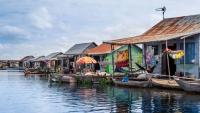In the central plains of Cambodia, at the end of a tributary linking it to the mighty river Mekong, lies a lake named Tonlé Sap. It is not a particularly impressive lake during the dry season, little more than a reedy swamp, but when the monsoon rains begin Tonlé Sap is filled by the flow of a unique reversing river.During the wet season the water level in the lake rises from just a metre to 10 times that depth. At the same time, the surface area more than quadruples to cover 15,000 sq km. The increase in water is caused by a remarkable hydrological phenomenon driven by the Mekong, one of the world’s largest rivers. When the south-west monsoon season begins in June, the Mekong suddenly swells into a raging torrent. Its water level rises so fast that not all of the water can escape to the sea.Instead, some of the floodwater runs into the Tonlé Sap river, which joins the Mekong at Phnom Penh.The force of water causes the river’s current to be reversed, north towards Tonlé Sap lake. For the next four or five

months, the river flows upstream instead of down. Since it is the lake’s only outlet, the water has nowhere else to go, so the lake fills.This is the world’s only naturally reversing river on a regular seasonal basis. Some rivers in cold latitudes may get reverse flow on occasion due to ice damming; surface flow can sometimes reverse on rare occasions and for short periods due to high winds (for example on the Detroit River); and famously, the Chicago River was made to ‘flow backwards’ in a vast civil engineering project at the start of the 20th century.The Tonlé Sap’s extraordinary change of direction drives the regional rhythms of nature. As the annual waters rise, large tracts of shrub land and forest become inundated, providing excellent breeding and feeding grounds for large numbers of fish, including carp and catfish. When the waters drop, some fish survive in small, remnant ponds on the floodplain, but this makes them easy prey for fishermen.Other species have developed special adaptations. The walking catfish and climbing perch, as their names suggest, are capable of crossing dry land in search of water when their ponds shrink or disappear during the dry season. They possess accessory breathing-organs, located above reduced gills, which allow them to breathe directly from the atmosphere.The human population has also adapted to the annual pulse of floodwater. Some of the fishing villages are built on stilts, others consist of floating houses. Here, where the children learn to swim before they can walk, they punt to and from floating schools. Every year, Cambodia’s largest festival, Bon Om Tok (the water festival), is celebrated in October and November as the Tonlé Sap river reverses once again and starts draining the lake back into the Mekong.This oscillating body of water has played a central role in the history and culture of the Khmer people. Just to the north of Tonlé Sap lies the great complex of Angkor Wat. Over a thousand years ago fish from the lake were made prominent in the carved bas-relief galleries at the Angkorian temples.
The author is a lecturer in physical geography and fellow of St Anne’s College, Oxford.